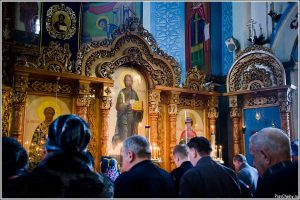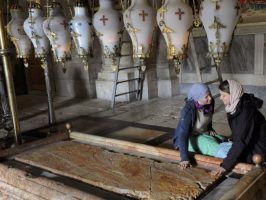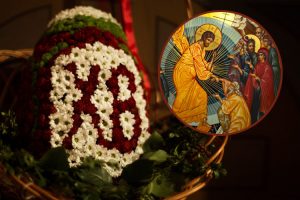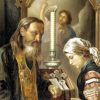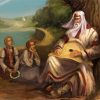Source: Holy Cross Orthodox Church
It is the feast of feasts, the holiday of holidays, which surpasses not only human feasts, but even feasts of Christ, as the light of the sun is brighter than that of the stars. It is the day of resurrection and the beginning of true life.”
St. Gregory of Nazianzus
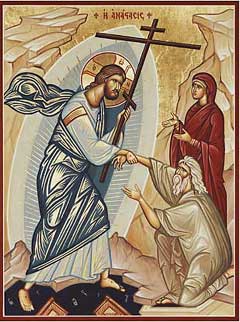 We have just celebrated the true Pascha, or passover, of our Lord. This is the passing over from death to life, from bondage to freedom, from darkness to light, from suffering to healing. We are now reveling in the light of His glorious resurrection. The brightness of these days is our participation in this “true life” that St. Gregory speaks of above. We can see it all around us in nature. St. Gregory goes on to list many things in nature that reveal to us this new life springing up in his homily on Pascha. He says that everything is “conspiring together, rejoicing together, for the beauty of this feast.” Everything all around us is hymning Christ who has sprung up from the tomb in order to bestow life on the whole world. He begins, “Now the heaven shines more brightly, the sun stands higher and glows more golden; now the moon’s orb is more radiant, the chorus of stars gleams more clearly. Now the sea’s waves make their peace with the shores, the clouds with the sun, the winds with the air, the earth with the plants, the plants with our eyes. Now the springs gush forth with a new sparkle; now the rivers flow more abundantly, released from the bonds of winter’s ice. Now the meadow is fragrant, the shoots burst forth, the grass is ready for mowing, and the lambs skip through the rich green fields… All things sing God’s praise, and give Him glory with wordless voices. For God receives my thanks for all these things: so each of their songs becomes our hymn, for I make their hymnody my own!… Now is the world’s spring, the spiritual spring, spring for our souls, spring for our bodies, spring visible, spring invisible.”
We have just celebrated the true Pascha, or passover, of our Lord. This is the passing over from death to life, from bondage to freedom, from darkness to light, from suffering to healing. We are now reveling in the light of His glorious resurrection. The brightness of these days is our participation in this “true life” that St. Gregory speaks of above. We can see it all around us in nature. St. Gregory goes on to list many things in nature that reveal to us this new life springing up in his homily on Pascha. He says that everything is “conspiring together, rejoicing together, for the beauty of this feast.” Everything all around us is hymning Christ who has sprung up from the tomb in order to bestow life on the whole world. He begins, “Now the heaven shines more brightly, the sun stands higher and glows more golden; now the moon’s orb is more radiant, the chorus of stars gleams more clearly. Now the sea’s waves make their peace with the shores, the clouds with the sun, the winds with the air, the earth with the plants, the plants with our eyes. Now the springs gush forth with a new sparkle; now the rivers flow more abundantly, released from the bonds of winter’s ice. Now the meadow is fragrant, the shoots burst forth, the grass is ready for mowing, and the lambs skip through the rich green fields… All things sing God’s praise, and give Him glory with wordless voices. For God receives my thanks for all these things: so each of their songs becomes our hymn, for I make their hymnody my own!… Now is the world’s spring, the spiritual spring, spring for our souls, spring for our bodies, spring visible, spring invisible.”
What powerful words that express even the creation’s response to the Pascha of our Lord. There are two paschas that we celebrate. The first is our Lord’s and the second is our own. But these are not mutually exclusive either. Our passover from death to life is made possible by Christ’s glorious resurrection. We are those in the tombs whom Christ has come to free and release. We are Adam and Eve that are being yanked out of the slumber of death. It is in these radiant days that we must continue to shine forth the glory of Christ’s resurrection by a radiant life. We become part of this new creation. What we also feast is our own passing from the tyranny of sin and death to victory and joy in the Kingdom. Just as we learn to fast and prepare ourselves to meet Christ during the sojourn of the Great Fast, so must we learn how to truly feast. Feasting is not just about eating meat and dairy products. True Christian feasting especially at Pascha is to offer ourselves to Christ in this new creation where we have died with Christ and become partakers of Him in His resurrection. Thus our feasting becomes a continual offering of ourselves to Christ. It is a feast of renewal where we put off the old man, and walk in newness of life (Eph. 4:22). “Let your old person become new! Celebrate the renewal of your soul!” says St. Gregory, stressing to us how we can continue to feast the resurrection. He urges us to, “Put restraints on everything that is the source of death, train all your members, develop a hatred for all the evil fruit of the tree… This is the way a human person is renewed, this is how the Day of Renewal should be honored: with this kind of finery, with a banquet such as this!… Bring this as your offering to the festival: be changed for the better… Scripture does not wish you to remain always as you are, but to be constantly in motion, beneficially in motion, even ‘a new creation’ – if you are a sinner, turning towards the good, and if you are upright, holding to your course.”
So we see that we must continue in this paschal victory during this whole season and into all of our life. Pascha should be a beginning rather than an end. We are so accustomed in our culture to spend all of our energy on our preparation for an event and then when the event occurs, we relax and “take a break.” Well, within the life of the Church where we participate in Christ Himself every feast, every Liturgy is a beginning, a renewal, a rebirth into Christ. This is why we feast Pascha for forty days and then await the coming of the Holy Spirit. We begin to enter into Kingdom time where we begin to see all of our life transformed into the presence of the Holy Trinity. Our sin, death, impossible situations, disappointments, struggles, losses, start to shine somehow with the light of Christ who shone forth from the tomb. This is where the light of Pascha begins to dawn in our hearts. St. Makarios of Corinth developed this idea and we find in a wonderful paraphrase of one of his homilies elaboration on this theme. “When you hear that Christ descended into hell in order to deliver the souls dwelling there, do not think that what happens now is very different. The heart is a tomb and there our thoughts and our intellect are buried, imprisoned in heavy darkness. And so Christ comes to the souls in hell that call upon Him, descending, that is to say, into the depths of the heart; and there He commands death to release the imprisoned souls that call upon Him, for He has power to deliver us. Then, lifting up the heavy stone that oppresses the soul, and opening the tomb, He resurrects us – for we were truly dead – and releases our imprisoned soul from its lightless prison… What was the purpose of His descent to earth except to save sinners, to bring light to those in darkness and life to the dead?” So let us feast Christ’s resurrection continually for today Christ is risen and “not one dead remains in the tombs.” Christ is risen! Indeed He is risen!












